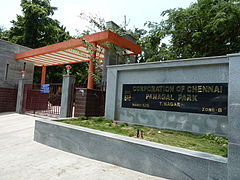Panagal Park
Coordinates: 13°02′29″N 80°13′59″E / 13.0413°N 80.2331°E
| Panagal Park பனகல் பூங்கா | |
|---|---|
 Entrance of Panagal Park | |
| Lua error in Module:Mapframe at line 764: attempt to index field 'wikibase' (a nil value). | |
| Type | Urban park |
| Location | T.Nagar in Chennai, India |
| Area | 8 acres (3.2 hectares) |
| Created | c. 1923 |
| Operated by | Corporation of Chennai |
| Status | Open all year |
Panagal Park is a park and a locality in Theagaraya Nagar, Chennai. The park is named after the Raja of Panagal, the Chief Minister of Madras Presidency who created the park. It is an important junction and is the commercial centre of T Nagar.
History[edit]
When the Long Lake on the western peripheral region of the old city was drained out and the area of T. Nagar was newly carved out of the existing neighborhood of Mambalam in 1923, a park was developed in the centre of the new locality intended to be a residential one. The park was named Panagal Park honouring the then Chief Minister of Madras, the Raja of Panagal.[1]
In the early days, there was a public radio inside the park to cater the visitors who gathered there to listen to music and news and stayed till the last news broadcast at 7.15 p.m.[1]
The architect of Panagal Park was Ganesh Iyer.
The park[edit]
The park covers 8 acres (3.2 hectares) and has three entry points.[2] As of 2019, the park has about 218 trees, including gulmohar, neem, peepal, almond, big-leaf mahogany, mast trees, and West Indian elms.[3]
Renovation[edit]
In 2008, the Chennai Corporation started renovating the park at a cost of ₹ 13 million. The renovated works included construction of children's play area and public convenience (₹ 1.182 million), beautification of the three entry points (₹ 2.281 million), development of lotus pond and sitting gallery (₹ 2.881 million), construction of walkways (₹ 4.370 million) and development of landscaped lawn (₹ 2.418 million).[4]
The renovated park was reopened on 21 February 2010.
Commercial establishments[edit]
Panagal Park is a landmark to many commercial establishments and department stores. Almost all the shops offering Textiles and Jewellery are concentrated on South Usman Road and Ranganathan Street.
Several high-end retail stores surround the park, including Saravana Stores, Lalithaa Jewellery, Nalli Chinnasamy Chetti, Pothys, RMKV, and Sri Kumaran Silks.
There are two educational institutions of repute around the park apart from commercial establishments. Sri Ramakrishna Mission Higher Secondary School for Boys and Sri RKM Saradha Vidyalaya Girls Higher Secondary School.
Roads[edit]
Six arterial roads radiate outwards from the park:
- North Usman Road goes north towards Kodambakkam
- G N Chetty Road goes northeast towards Gemini Circle
- Thyagaraya Road (known as pondy bazaar ) goes east towards Teynampet Signal
- Venkatanarayana Road goes southeast towards Nandanam Junction
- South Usman Road goes south towards Saidapet
- Doraiswamy Road goes west towards West Mambalam
See also[edit]
References[edit]
- ↑ 1.0 1.1 Varghese, Nina (29 August 2006). "T.Nagar: Shop till you drop, and then shop some more". Business Line. Chennai: The Hindu. Archived from the original on 26 September 2012. Retrieved 14 January 2013.
- ↑ "Panagal Park to be renovated". The Hindu. Chennai. 27 June 2008. Archived from the original on 30 June 2008. Retrieved 22 July 2012.
- ↑ Majumdar, Meghna (8 May 2019). "Fading canopies". The Hindu. Chennai: Kasturi & Sons. pp. MetroPlus (p. 5). Retrieved 12 May 2019.
- ↑ "Panagal Park to get facilities". The Hindu. Chennai. 26 January 2010. Archived from the original on 30 January 2010. Retrieved 22 July 2012.
